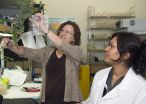INFORMATION:
For more information:
Doty, 206-616-6255, sldoty@uw.edu
Khan, 206-543-5774, zareen@uw.edu
Suggested websites
Publication " Degradation, Phytoprotection and Phytoremediation of Phenanthrene by Endophyte Pseudomonas putida, PD1"
Environmental Science & Technology
Sharon Doty
'Probiotics' for plants boost detox abilities; untreated plants overdose and die
2014-11-17
(Press-News.org) Scientists using a microbe that occurs naturally in eastern cottonwood trees have boosted the ability of two other plants - willow and lawn grass - to withstand the withering effects of the nasty industrial pollutant phenanthrene and take up 25 to 40 percent more of the pollutant than untreated plants.
The approach could avoid the regulatory hurdles imposed on transgenic plants - plants with genes inserted from or exchanged with other plant or animal species - that have shown promise in phytoremediation, the process of using plants to remove toxins from contaminated sites, according to Sharon Doty, associate professor of environmental and forestry sciences and corresponding author on a paper about the new work in Environmental Science & Technology.
"Our approach is much like when humans take probiotic pills or eat yogurt with probiotics to supplement the 'good' microbes in their guts," she said.
The microbe from the cottonwood was encouraged to colonize the roots of willows simply by dipping rooted and trimmed cuttings in solutions with the microbe. Grasses were treated with microbes in solution as seeds sprouted in soil. Once integrated into the plants, the microbe supplemented their own microbial defenses.
Microbes that take up residence in the inner tissue of plants and don't cause negative symptoms are called endophytes. In nature, endophytes have a welcomed, symbiotic relationship with plants. In polluted soil, for instance, if the right endophytes are present they consume toxins coming up through plant roots. The endophytes get fed and the plant gets help neutralizing pollutants that could kill it.
That's been one challenge of phytoremediation: plants removing pollutants can, all too quickly, succumb to the toxins.
"When the endophyte in these experiments was given to willow and grasses, it reduced the phytotoxic effects of phenanthrene compared to the control plants that did not receive the endophyte and died," said lead author Zareen Khan, a UW research scientist in environmental and forest sciences.
Phenanthrene is carcinogenic, on the Environmental Protection Agency's priority pollutants list and belongs to a class of polycyclic aromatic hydrocarbons that get deposited into the environment via fossil fuel combustion, waste incineration or as byproducts of industrial processes. Soils that become contaminated can be capped with layers of uncontaminated soil or dug up and removed for cleaning at soil remediation facilities or storage at waste disposal facilities.
In their search, UW researchers tested six different endophytes from cottonwood and willow varieties and found one - lab name PD1 - from the eastern cottonwood to be superior at breaking down phenanthrene.
They introduced this endophyte into willow cuttings and lawn grass. Willows were chosen because some varieties have already proven adept at removing toxins and the shrubs have extensive root systems, take up a lot of water and grow rapidly. Lawn grass was included because it also grows fast and could be useful in parks and open-space areas.
In lab experiments, the willow cuttings with added endophyte protection continued to grow, kept their leaves and had denser root systems. Untreated plants wilted, lost leaves and their roots turned brown. When soils were analyzed, the treated willows took up 65 percent of the phenanthrene compared with untreated plants that removed 40 percent, an improvement of 25 percent.
Grass seed planted in contaminated soils and watered with solutions containing the PD1 endophyte germinated five days quicker, grew taller and had 100 more tillers, or new offshoots, after 13 days. Treated grass removed 50 percent of the phenanthrene from the soil, compared with untreated grass that removed 10 percent, an improvement of 40 percent.
In phytoremediation, plants that take up pollutants but don't degrade them have to be removed and treated as hazardous waste or otherwise disposed of safely. The willows treated in the UW experiment appear to have degraded some 90 percent of the phenanthrene to harmless components. The researchers said they'd like to determine if that promising finding holds up in mass-balance studies and want to examine the possible effects on bugs or animals that might bite the plants processing the toxins and other environmental considerations. Interestingly, other studies have shown that bugs can smell similar semi-volatile pollutants and avoid eating the plants containing them, Doty said.
The work was funded by a Small Business Innovation Research grant from the National Institute of Environmental Health Sciences and by funds provided through the Byron and Alice Lockwood Endowed Professorship that Doty holds. The other four co-authors on the paper were undergraduate volunteers: David Roman and Trent Kintz have since graduated while May delas Alas and Raymond Yap are still working on their bachelor's degrees.
Just down the road from UW is Seattle's Gas Works Park, a site Doty thinks is a prime candidate for the approach her lab reported. Contaminants in the soil, including phenanthrene, are from a now-dismantled gasification plant. Soils have been covered with uncontaminated soil.
"The idea of leaving a known carcinogen in a public place is not right," she said. "What about problems of erosion? We should do what we can to remove it. We spend so much money treating cancer, I'd like us to take steps to prevent it instead."
ELSE PRESS RELEASES FROM THIS DATE:
Researchers present highly anticipated IMPROVE-IT results
2014-11-17
More than a decade ago, researchers from Brigham and Women's Hospital (BWH) demonstrated that a high dose statin, which lowered cholesterol further than a regular dose statin, provided better clinical outcomes. But questions remained about whether further reducing cholesterol would be even more effective in reducing cardiovascular-related events.
Now, results of the highly anticipated IMProved Reduction of Outcomes: Vytorin Efficacy International Trial (IMPROVE-IT), co-led by researchers at BWH and Duke Medicine, indicate that adding a second drug, ezetimibe, that blocks ...
Ten ways remote sensing can contribute to conservation
2014-11-17
WCS, NASA, And other conservation and remote sensing agencies, universities and NGOs focus on top 10 conservation questions for satellite technology
Remote sensing has and can continue to play a critical role in conserving Earth's biological diversity
Protected area management is a key use of remote sensing data
Newly formed Conservation Remote Sensing Network to apply remote sensing data to conservation challenges
NEW YORK (November 17, 2014)--Scientists from the WCS (Wildlife Conservation Society), NASA, and other organizations have partnered to focus global attention ...
Reprogramming cells, long term
2014-11-17
Harvard Stem Cell Institute (HSCI) researchers, representing five Harvard departments and affiliated institutions as well as the Massachusetts Institute of Technology (MIT), have demonstrated that adult cells, reprogrammed into another cell type in a living animal, can remain functional over a long period.
The work by Joe Zhou, an associate professor in Harvard's Department of Stem Cell and Regenerative Biology, and his collaborators is an important advance in the effort to develop cell-based therapies for tissue repair, and specifically in the effort to develop improved ...
UTHealth smoking study: Financial incentives double quit rates
2014-11-17
HOUSTON - (Nov. 17, 2014) - Offering small financial incentives doubles smoking cessation rates among socioeconomically disadvantaged smokers, according to research from The University of Texas Health Science Center at Houston (UTHealth). The findings were published last week in the American Journal of Public Health.
Tobacco use is the leading cause of preventable death in the United States, according to the Centers for Disease Control and Prevention. Thanks to public health efforts, smoking rates have declined to 18 percent among American adults. However, nearly 30 percent ...
Family ties that bind: Having the right surname sets you up for life
2014-11-17
If your surname reveals that you descended from the "in" crowd in the England of 1066--the Norman Conquerors--then even now you are more likely than the average Brit to be upper class. To a surprising degree, the social status of your ancestors many generations in the past still exerts an influence on your life chances, say Gregory Clark of the University of California, Davis, in the US and Neil Cummins of the London School of Economics in the UK. They used the Oxbridge attendance of people with rare English surnames (last names) to track social mobility from 1170 to 2012. ...
Behavioral flexibility impaired after exposure to oxycodone
2014-11-17
(NEW YORK - November 17) Brief usage of the painkiller oxycodone may impair behavioral flexibility even after that use ends, suggesting impaired decision-making as an enduring consequence of exposure, according to a study conducted at the Icahn School of Medicine at Mount Sinai and published November 17 in the journal Learning and Memory.
The Mount Sinai study investigated behavioral flexibility, the ability to select new responses when otherwise familiar circumstances change. In people and rodents exposed to drugs of addiction, repeated actions can become automated ...
Businesses can help preserve endangered species with small landscape changes
2014-11-17
Raptors, or birds of prey, some of which are endangered species, typically live in environments that provide natural land cover, such as forests and grasslands. Protecting endangered raptor species helps maintain food chain balance and prevents overpopulation of common raptor prey, such as snakes and rodents. As more businesses are built on the edges of urban areas, land where raptors once lived becomes industrialized, which raises concerns about the consequences of habitat destruction on raptor populations. Now, University of Missouri researchers have found that businesses ...
Newly discovered hormone with potential treatment for obesity, type 2 diabetes, liver disease
2014-11-17
ANN ARBOR -- Researchers at the University of Michigan have discovered how a previously unknown hormone serves as a messenger from fat cells to the liver and are investigating the potential of developing a new treatment for metabolic disorders.
Jiandie Lin of the Life Sciences Institute described how in mice the hormone, NRG4, is secreted by so-called brown fat cells and communicates with the liver to regulate the conversion of sugar into fat. Mice without NRG4 became obese and developed hallmarks of type 2 diabetes and fatty liver disease. When scientists genetically ...
NASA sees the Southern Indian Ocean cyclone season awaken
2014-11-17
The first tropical cyclone of the Southern Indian Ocean cyclone season has formed over 300 miles from Diego Garcia. When NASA-NOAA Suomi NPP satellite passed over Tropical Storm Adjali the VIIRS instrument aboard took a visible picture of the storm that showed bands of thunderstorms wrapped around its center.
NASA-NOAA's Suomi NPP satellite passed over Tropical Storm Adjali on Nov. 17 at 09:56 UTC (4:56 a.m. EDT) and the Visible Infrared Imaging Radiometer Suite (VIIRS) instrument aboard captured a visible picture of the storm. The VIIRS image showed that the storm ...
Middle managers and hermit crabs
2014-11-17
RIVERSIDE, Calif. (http://www.ucr.edu) -- Ideas from mid-level managers that can benefit an organization are less likely to be passed up to superiors as hierarchy in the organization increases, according to a just published paper by an assistant professor at the University of California, Riverside.
"I like to call this hermit crab syndrome," said Boris Maciejovsky, an assistant professor of management at UC Riverside's School of Business Administration. "When mid-level managers feel their ideas are not reflected in top management decisions they withdraw, like a hermit ...








